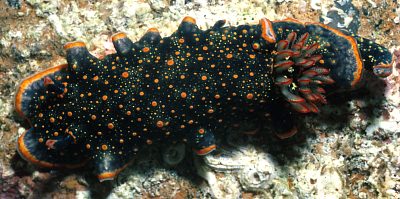
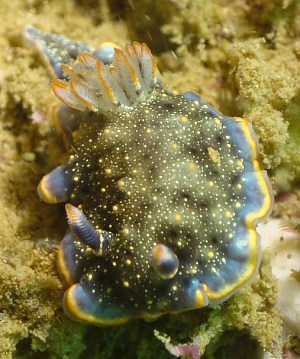
Glossodoris ghanensis
Edmunds, 1968
Order: NUDIBRANCHIA
Suborder: DORIDINA
Superfamily: EUDORIDOIDEA
Family: Chromodorididae
DISTRIBUTION
Eastern Atlantic Ocean - known from Ghana, Canary Islands and the Azores.
PHOTO
Upper: São Miguel, Azores, July 1988. Animals 15mm & 35mm in length, alive Photo: T.M. Gosliner
Lower: Dakar, Senegal, West Africa. Depth: 4m, June 05, 2003, 25-30mm long. Photo: Marina Poddubetskaia
The living animals are a translucent grey, the pigment often aggregating into dense almost black patches. There are rounded smooth orange tubercles scattered over the mantle and the foot and these are surrounded by smaller orange or yellow spots. At the mantle edge is a translucent clear band, inside of which is an orange band which grades in colour from dark on the outside to light on the inside. [In some specimens from red-brown to orange, and in others from red-orange to yellow]. Inside the orange band there is a region which is a mottled bluish white band, caused by the presence of numerous white mantle glands. The rhinophores are a dark bluish grey with an orange tip to the rhinophore club. From the orange tip, an orange line runs down the posterior midline and another orange line runs some distance down each side of the club. The rhinophoral and branchial pockets are surrounded by an orange ring. The gills are grey and semi-transparent with an orange pigmentation on the rachis edges. There is an orange line running around the posterior edge of the foot.
See my reasons for considering Glossodoris edmundsi, Cervera, Garcia-Gomez & Ortea, 1989 to be a synonym of G. ghanensis Edmunds, 1968.
References:
• Cervera, J.L., Garcia-Gomez, J.C. & Ortea, J.A. (1989). On two rare chromodorid nudibranchs (Opisthobranchia: Chromodorididae) from the Eastern Atlantic, with the description of a new species of Glossodoris, Journal of Molluscan Studies, 55: 445-453
• Edmunds, M. (1968) Opisthobranchiate Mollusca from Ghana. Proceedings of the Malacological Society of London, 38: 83-100.
• Edmunds, M. (1981) Opisthobranchiate Mollusca from Ghana: Chromodorididae. Zoological Journal of the Linnean Society, 72(2): 175-201.
• Gosliner, T.M. (1990). Opisthobranch Mollusks from the Azores Islands. 1. Runcinidae and Chromodorididae. Açoreana, supplement: 135-166
• Ortea, J., Valdes, A. & Garcia-Gomez, J.C. (1996) Review of the atlantic species of the Family Chromodorididae (Mollusca: Nudibranchia) of the blue chromatic group. Avicennia (Suppl. 1): 1-160.
Rudman, W.B., 2003 (May 18) Glossodoris ghanensis Edmunds, 1968 . [In] Sea Slug Forum. Australian Museum, Sydney. Available from http://www.seaslugforum.net/find/glosghan
Related messages
Glossodoris ghanensis laying eggs
June 23, 2005
From: Marina Poddubetskaia
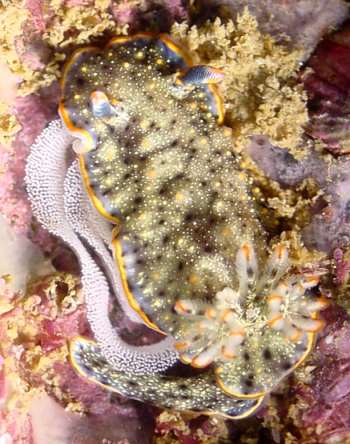
Dear Bill,
Here is a photo showing Glossodoris ghanensis laying eggs. This species is extremely common in Dakar in shallow waters, at least at this period of the year.
Locality: 'Ile de Gorée', Dakar, Senegal. Atlantic Ocean. Depth: 6 m. Length: 25 mm. 01 June 2005. Photos: Marina Poddubetskaia - Nembro website
Also, please note the double spiral of gills in this specimen. This species always looked to me like Chromodoris, but with kind of gills there are no doubts about the genus.
Best wishes,
Marina.
nembro@nembro.info
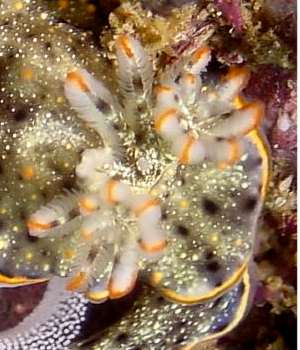
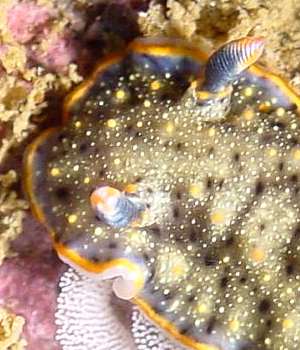
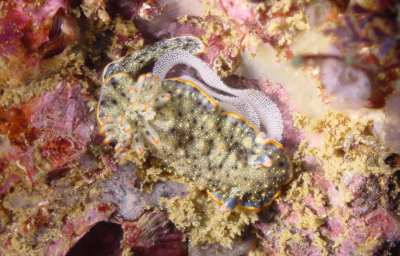
Dear Marina,
Thanks for this photo. This animal has one of those colour patterns which looks spectacular close-up, or in a dish, but in their natural environment allow the animal to blend in and become almost invisible.
Concerning the double spiral in the gills. Although most species of Glossodoris have a double spiral, it is not exclusive to them. This species belongs to a group within Glossodoris with a more Chromodoris-like body shape. However their reproductive system is typical of other Glossodoris species. That is not to say that some time in the future we will decide that they should be split off as a separate genus.
Best wishes,
Bill Rudman
Glossodoris ghanensis from Senegal
June 26, 2003
From: Marina Poddubetskaia

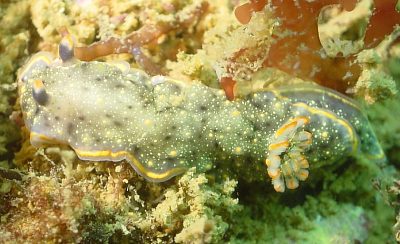
Dear Bill,
I spent 2 weeks diving in Dakar, Senegal and I was filled with wonder at the biodiversity of these waters. I will start my contribution with these nice chromodorids. I think it is Glossodoris edmundsi Cervera, Garcia-Gómez, & Ortea, 1989 and I'd like to have your confirmation.
I found these guys in only one diving site, but here they were in large numbers. But nevertheless, I didn't find any one laying eggs (and yet I saw many characteristic egg-ribbons).
These chromodorids are very difficult to photograph because their notum is very reflective. In first photos I had a large light spot instead of animals' mantle. So, I had to adapt my lighting to have better
Location: Dakar, Senegal, Eastern Atlantic
Site: Terou baye Sogui
Depth: 4m
Upper Photo: June 05, 2003, 25-30mm long.
Lower Photo: May 30, 2003, 30mm long.
Photos: Marina Poddubetskaia - Nembro website
Best wishes,
Marina.
nembro@nembro.info
Poddubetskaia, M., 2003 (Jun 26) Glossodoris ghanensis from Senegal. [Message in] Sea Slug Forum. Australian Museum, Sydney. Available from http://www.seaslugforum.net/find/10203Dear Marina,
I have recently discussed my views on G. edmundsi. Basically I think it is a colour form of Glossodoris ghanensis and your photos are a very useful addition to the evidence supporting that opinion. In particular, your upper photo is almost identical to one identified by Edmunds (1981: Fig 12B) as C. ghanensis. In your animals, like those described by Edmunds, the black pigment on the mantle is mainly restricted to scattered black diffuse spots.
Glossodoris edmundsi from the Azores
May 22, 2003
From: Terry Gosliner

Hi Bill,
Here is the first of a series of photos I am sending of animals from the Azores. This photo is of Glossodoris edmundsi.
São Miguel, Azores, July 1988. Animals 15mm & 35mm in length alive. Photo: T.M. Gosliner
Further details can be found in my Azores paper,
• Gosliner, T.M. (1990). Opisthobranch Mollusks from the Azores Islands. 1. Runcinidae and Chromodorididae. Açoreana, supplement: 135-166
Best wishes,
Terry Gosliner
tgosliner@calacademy.org
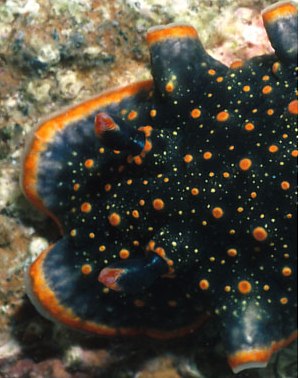
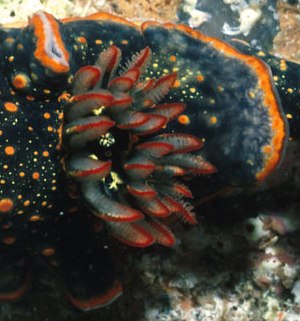
Dear Terry,
Thanks very much for filling another gap. I checked my notes on this species and found I had scribbled some comments essentially saying that I could see no difference between G. ghanensis Edmunds, 1968 and G. edmundsi Cervera, Garcia-Gomez & Ortea, 1989. I have prepared my views as a separate message and would appreciate your comments.
Best wishes,
Bill Rudman
Glossodoris edmundsi and G. ghanensis
May 22, 2003
From: Bill Rudman

Terry Gosliner's photo from the Azores of what he has identified as Glossodoris edmundsi Cervera, Garcia-Gomez & Ortea, 1989 gives me the opportunity to discuss this and G. ghanensis Edmunds, 1968, which I consider to be the same species. In their description of
Colour: There is some variation in background colour, with the grey black pigmentation in some animals being less intense than in others. The orange pigmentation can also vary from orange-red to orange-yellow. However, in all essential points there are no differences in colour pattern, including such fine detail as the 3 orange lines on the rhinophore clubs - one in the posterior midline, and one on each side running from the tip to about halfway down the club. (Gosliner, 1990; Edmunds, 1981; Ortea et al, 1996) Another feature of the colour pattern which shows both colour variation and fine detail is the submarginal orange border. In Edmund's original description of G. ghanensis (1968) he desribes the border as 'orange' but in 1981 he describes it as 'orange merging into yellow' which is clearly visible in the accompanying colour photo. Although both Cervera et al (1989) and Ortea et al (1996) describe the border of G. edmundsi as 'orange', in Gosliner's photo it is submarginal and grades from a dark brownish orange on the outside to lighter orange on the inside.
Radula: Cervera et al (1989) compare the radula of a 14mm long alive specimen of G. ghanensis from Ghana, and a 34-5mm long specimen alive of G. edmundsi from the Canary Ids. The Ghanaian animal is almost certainly immature, and the teeth of immature specimens are usually more denticulate than adults. Taking into account the differing maturity of the animals compared and the fact that the comparisons were made from light microscope mounts, I can see no major conflict in the denticulation of the outer teeth in the two descriptions. If you compare Edmunds' (1968) drawing of the outer teeth of a specimen from Ghana, with Ortea et al's (1996) SEM photo of the outer teeth of a specimen from Madeira, and Gosliner's (1990) from the Azores, they look very similar.
Reproductive System: As with the radular morphology, I would suspect the comparison of the reproductive systems (Cervera et al, 1989) is based on an immature specimen of G. ghanensis. I am not sure therefore how much weight we can put on differences in relative lengths of ducts, or sections of ducts in the reproductive systems. Certainly in juveniles, parts that in maturity become glandular, or muscular, are present as long, often coiled, thin-walled ducts, the glandular and muscular coatings appearing gradually as the animal matures. It is therefore difficult in immature or half grown animals to identify particular sections of the male duct. Later dissections by Ortea et al (1996) and Gosliner (1990) illustrate the reproductive system of G. edmundsi and both have differences in the relative lengths and thicknesses of parts of the male duct.
Finally, the most recent review of G. edmundsi studied specimens from Azores, Madeira, and Ghana (Ortea et al, 1996). If G. edmundsi and G. ghanensis both occur in Ghana, this is either an amazing case of mimicry or we are dealing with the same species. Clearly mimicry cannot be ignored, as the chromodorids are well-known for their groups of similarly coloured species. However, in my experience, species mimicking each other are never identical, there are always slight differences, perhaps in rhinophore or gill colour, or perhaps an extra colour bordering the mantle. Differences in colour pattern should not be confused with variation in colour pigment. As we see in these two 'species', variation in intensity and shade of a particular colour - say from orange-red to orange-yellow - is quite normal in many nudibranchs. Variation in colour intensity however, does not alter the colour 'pattern' of a species, which we can define as the manner in which all the colours are arranged in a particular species.
• Cervera, J.L., Garcia-Gomez, J.C. & Ortea, J.A. (1989). On two rare chromodorid nudibranchs (Opisthobranchia: Chromodorididae) from the Eastern Atlantic, with the description of a new species of Glossodoris, Journal of Molluscan Studies, 55: 445-453
• Edmunds, M. (1968) Opisthobranchiate Mollusca from Ghana. Proceedings of the Malacological Society of London, 38: 83-100.
• Edmunds, M. (1981) Opisthobranchiate Mollusca from Ghana: Chromodorididae. Zoological Journal of the Linnean Society, 72(2): 175-201.
• Gosliner, T.M. (1990). Opisthobranch Mollusks from the Azores Islands. 1. Runcinidae and Chromodorididae. Açoreana, supplement: 135-166
• Ortea, J., Valdes, A. & Garcia-Gomez, J.C. (1996) Review of the atlantic species of the Family Chromodorididae (Mollusca: Nudibranchia) of the blue chromatic group. Avicennia (Suppl. 1): 1-160.
Best wishes,
Bill Rudman
